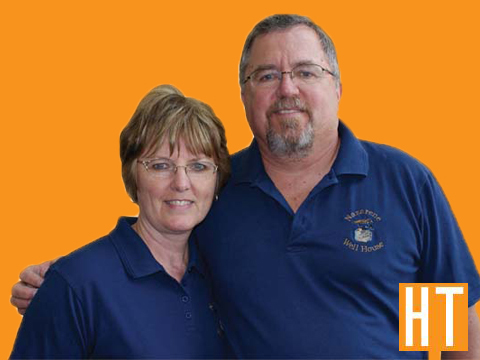Building a Well House in the Shadow of a Legend

Certain medical facilities are known around the world for their extensive care. British born William W. Mayo, a frontier physician, launched a medical practice that in time, engaged his sons. From those roots grew the Mayo Clinic, now with three locations. The original site, in Rochester, Minnesota, is the largest with 1,900 doctors and scientists.
Rochester Church of the Nazarene's pastor, Pat Thomas, and his wife, Penny, along with the church board felt a need to offer compassionate care to Mayo clinic patients and their families. More than temporary, affordable lodging, they longed to provide a home away from home for guests who might be facing life-altering health situations.
Following a time of intense prayer the church board unanimously voted to pursue a home for those with medical needs, located close to the Mayo Clinic.
In late 2007, the Rochester Church of the Nazarene sold their parsonage and used the proceeds to help finance Well House. Some neighborhood groups were not warm to the idea of having a communal home in the area, although several churches in Rochester do have such homes. Another option was to purchase a small apartment building, but that seemed less than ideal, considering the congregation wanted a center that would be, in a sense, a home for the patients and their families.
Various options came and went. Nothing ever seemed right, or the financial arrangements did not work. Pastor and congregation learned an important life lesson in this process. Following through on a dream does not necessarily mean the dream will come to fruition easily.
Eventually, the current property became available. The church was able to purchase the 7,500-square foot facility for $100,000 (USD) less than the apartment building would have cost. The 90-year-old building was built to be a small hotel and more recently, a mental health facility.
During the 1950s, the building was moved from downtown Rochester to its current location on the Zumbro River. The facility has 12 bedrooms, a great room common area, a kitchen, and full-time caretakers who live in a lower-level apartment. Situated by the river, its two porches and garden help create a restful setting.
They hired a general contractor and other professionals to help with electrical and plumbing, but several from the professional team volunteered their services or donated goods. Members of the congregation engaged in extensive weekend projects at the house.
Prior to its opening, and following the Old Testament example, the congregation walked around the Well House seven times, praying for this to be a place of peace and tranquility, a place where God's presence could be felt.
The project was completed in 2008. They had their first guest in June of that year. Often the house is full to capacity. The need is greater than their ability to meet the need. Suggested donations are $25 (USD) per night per room.
The stories within the story help create interesting chapters.
Not long ago, a couple came to Nazarene Well House from Des Moines, Iowa. The husband had been diagnosed with cancer of the esophagus. The wife shared that the previous Sunday they had visited a church where someone told them, "God will provide for you."
Since only one night was available at Well House, Pat mentioned that a family in their church, Dave and Sandy Huikko, had an extra bedroom available. The couple took him up on the offer. But before they went to the Huikko home, they sat with the pastor on the Well House porch along with another Nazarene couple who were touring the house. Meaningful conversation on that porch allowed Pat the opportunity to share about Christ. As they listened to simple yet profound truths, the couple from Iowa prayed to receive Christ as their Savior.
Then, the couple went and enjoyed the warm hospitality of the Huikkos. On Sunday, Pat asked Sandy if she still had house guests. No, the couple had returned to Des Moines. Before they left Rochester, they had written a note to the Huikkos sharing that the husband was cancer free. They were returning home praising God.
Many people say if it wasn't for the Nazarene Well House, they would not have been able to afford treatment at the Mayo Clinic. Not all medical treatment at the clinic requires hospitalization. Some treatments are outpatient. For those experiencing an intense medical condition, travel and lodging expenses can be financially draining.
One woman whose husband was dying of cancer would take short breaks from her husband's bedside, and shared how she felt God's presence at the Well House during those moments of respite.
A family from Illinois, originally from Taiwan, visited the Well House when the mother was being treated at Mayo for lung cancer. The Well House became their home away from home.
Meals, for the most part, are provided by area businesses or by guests who want to cook for one another.
"When someone calls me and tells me that a loved one is at the Mayo Clinic" says Pat, "I want to be their pastor and to do what I can to minister to them. Furthermore, this ministry is a step in building a stronger church. And Well House raises awareness in the community about the Church of the Nazarene."
Immediate goals for the Well House are to care for the debt and to add shuttle service to and from the house and clinic.
Seeing a dream fulfilled is not the end for the Thomases nor for the Rochester congregation. Rather, this milestone has triggered their imaginations to conceive of even bigger things that God can do, with their help.
Carmen J. Ringhiser is managing editor of Holiness Today.
A Note From the Pastor
I found the Church of the Nazarene while in the throes of contemplating a divorce. Pastor Doug Perkins allowed a ministry to be developed at the Litchfield, Minnesota, Church of the Nazarene called "Set Free Ministry." My nearly ex-wife attended two of these sessions, and came home and suggested that I attend.
At that time, church wasn't a part of my life. But I figured attending a meeting couldn't hurt anything.
The night I attended the meeting was part of a journey that led to my sanctification. I was a believer, but wasn't sanctified. The leader of the meeting encouraged me to read Romans 7:15-20. That scripture explained who I was. And that was the first step.
Through the Set Free meetings, I found spiritual and emotional healing, as well as healing for my marriage. Pastor Perkins recognized that I had a call to ministry and gave me my local pastor's license. Until then, I was a supervisor at a manufacturing plant, a farmer, and in the Army Reserves. Pastoring wasn't on my mind at all. But through the process of yielding myself to the Lord, He directed my path to this vocation.
I was appointed pastor of the St. Paul, Minnesota, First Church of the Nazarene, which had eight attendees and was on the brink of closure. Our district superintendent at the time, Samuel Pickenpaugh, said when appointing me, 'He can't ruin anything.' The concept being that there wasn't much left to ruin. I pastored there for five years before taking the Rochester church in 2001.
The Rochester church is also home to a Cambodian congregation. So we have outreach through the Well House and our two congregations. Every community has unique ministry opportunities. What might work in Rochester might not work in another location. Some communities have a large ethnic group to whom the church can minister. Another community might have unique buildings such as an available theater that could set the "stage" for ministry. In Rochester, everything is done in the shadow of the Mayo Clinic. But wherever we serve, we need a vision and then a plan to follow through on that vision.
Pat Thomas is pastor of Rochester, Minnesota, Church of the Nazarene.
Holiness Today, Jan/Feb 2010
Please note: This article was originally published in 2010. All facts, figures, and titles were accurate to the best of our knowledge at that time but may have since changed.




